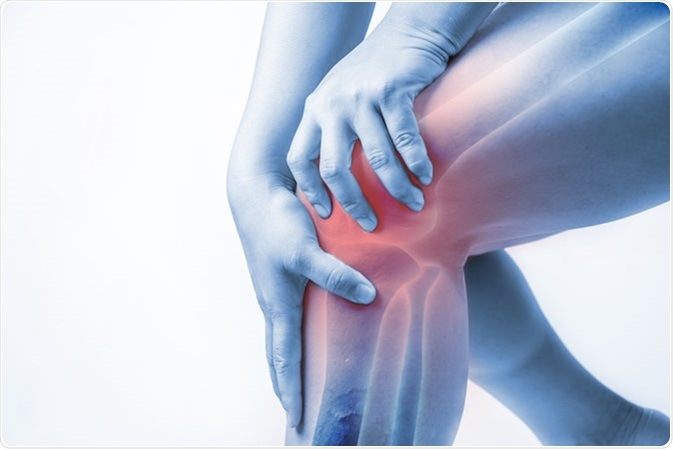Calcium pyrophosphate deposition (CPDD) disease is characterized by the accumulation of calcium crystals in the cartilage tissues of the joints. The crystal deposits cause inflammation of the affected joint, and in severe cases it leads to cartilage rupture.
The disease is polyarticular in most of the patients and develops spontaneously; however, in some patients, it may develop after previous injury or trauma. The knee joint is involved in most cases; however, the wrist, ankles and hips may also be affected by CPPD.

Image Credit: Kamomeen / Shutterstock
Forms of CPPD
CPPD may manifest in several forms:
Pseudogout - Pseudogout is the acute form of CPPD, which is due to intercurrent conditions. The symptoms resemble those of gout; however, they tend to be less debilitating. The condition is self-limiting and usually resolves in a few weeks. Pseudogout can be differentiated from gout by examining the specific crystals deposited in the inflamed joints.
Pseudogout | Pathophysiology, Symptoms and Treatment
Chronic form – The chronic form progresses slowly and causes degenerative changes which take several months to resolve. This form resembles rheumatoid arthritis, and radiological examination will be necessary to differentiate the two.
Asymptomatic CPPD – The asymptomatic form is devoid of any symptoms and needs no treatment.
What causes CPPD?
The exact reason for crystal deposition in the cartilage is not known. However, it is believed that ageing is the most important risk factor for CPPD arthritis.
Other factors that show a strong association with this condition include joint trauma or sepsis, or procedures such as joint lavage, can cause shedding of calcium crystals into the joint.
Genetic factors are also held responsible for the development of CPPD in a few cases. Once the crystals reach the joint space, a cascade of inflammatory reactions is initiated; which ultimately cause the painful symptoms.
Recent research has shown that CPPD disease is associated with various metabolic disorders such as hemochromatosis and hyperparathyroidism.
What are the signs and symptoms of CPPD?
In acute cases the symptoms include painful joints which may also feel hot and stiff. Fever generally accompanies such acute attacks.
The chronic form of CPPD disease shows a chronic rheumatoid arthritis-like progression. This form may involve several joints, mostly in a symmetric pattern. There is less intense inflammation and pain as compared to an acute attack. Morning stiffness and fatigue are some other characteristic features of the chronic form. The condition causes degenerative changes and ultimately leads to joint deformity.
How is CPPD diagnosed?
The close resemblance of CPPD disease to other forms of joint diseases makes the process of differential diagnosis a challenging task. Clues are offered by the presence of features such as:
- Acute inflammation of one or a few joints (pseudogout)
- Chronic joint inflammation in joints characteristically involved in rheumatoid arthritis (pseudo-rheumatoid arthritis)
- Chronic pain in joints typically uninvolved in osteoarthritis (pseudo osteoarthritis)
Normal uric acid levels are typical. Calcium and phosphorus levels are typically normal as well, as are parathyroid hormone and magnesium levels.
Identification of CPPD crystals is the key to definitive diagnosis.
Synovial fluid analysis and imaging techniques such as X-rays are commonly used for diagnosis. In synovial fluid analysis by polarizing microscopy, CPPD crystals are seen as rhomboidal or rod-shaped with a slight birefringent structure. Calcification of the hyaline cartilage can be observed in X-ray analysis.
How is CPPD treated?
The treatment strategy for CPPD disease primarily focuses on relieving symptoms and improving joint function. Pain management is done by using medications that relieve inflammation, such as nonsteroidal anti-inflammatory drugs (NSAIDS) and colchicine. Intra-articular corticosteroid injections are used in severe cases.
Self-care also forms an important part of disease management. The use of cold packs can help reduce inflammation. In addition, resting painful joints is also important to relieve symptoms.
Even though the disease affects a good number of patients, CPPD disease is often neglected by the medical fraternity. The use of a definite diagnostic strategy and the discovery of effective therapies could definitely be game-changers for victims of this disease.
Further Reading